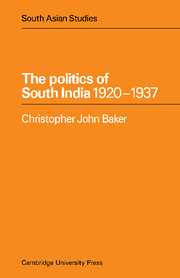Book contents
- Frontmatter
- Contents
- List of maps and tables
- Preface
- Notes on references, transliteration and abbreviations
- 1 Madras Presidency–natural features, regions and languages
- 2 Madras Presidency – districts
- 3 Madras Presidency – municipal towns
- 1 Politics and the Province: the Justice party
- 2 The province and the locality
- 3 Depression, dissent and disengagement
- 4 The ascent of the congress
- Conclusion
- Biographical notes
- Glossary
- Bibliography
- Index
4 - The ascent of the congress
Published online by Cambridge University Press: 27 October 2009
- Frontmatter
- Contents
- List of maps and tables
- Preface
- Notes on references, transliteration and abbreviations
- 1 Madras Presidency–natural features, regions and languages
- 2 Madras Presidency – districts
- 3 Madras Presidency – municipal towns
- 1 Politics and the Province: the Justice party
- 2 The province and the locality
- 3 Depression, dissent and disengagement
- 4 The ascent of the congress
- Conclusion
- Biographical notes
- Glossary
- Bibliography
- Index
Summary
The changes in the structure of power between 1920 and 1940 sent reverberations throughout the province. The important corridors of power were creations of the British Raj, and until 1930 or thereabouts the British took some trouble to control access to them. The allocation of important jobs in the public services and the gift of ministerships under dyarchy were closely monitored by the provincial Governor and his aides. To seek favour and advancement, men had to present themselves to the rulers. But as the British began to disentangle themselves from affairs of locality and province, the ingredients of political success changed rapidly. In local government, the amendment acts of 1919–20 saw a considerable withdrawal by the Raj, yet the lingering influence of the ministers ensured that local politicians still had to focus their attention on the fount of imperial power. In the early 1930s the Raj started to withdraw from the provinces. The Governor stood aloof from the political intrigues of the ministers and their circle; he and the leading I.C.S. men took a smaller part in the affairs of the Legislative Council; and finally in the Government of India Act of 1935 the Raj virtually withdrew altogether from provincial government. Politicians who had before looked to please their masters, now had to look to please their constituencies. This was not a sudden change; for many years politicians had had to strive to please both the rulers and the ruled. Yet the 1930s was a time of crucial change.
- Type
- Chapter
- Information
- The Politics of South India 1920–1937 , pp. 245 - 319Publisher: Cambridge University PressPrint publication year: 1976



